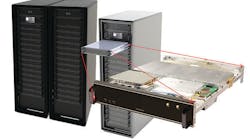Solid-State Amplifier Architecture Serves High-Power Applications
A new liquid cooled and scalable architecture from Empower RF Systems replaces tubes with solid-state technology to bring new capabilities to applications calling for tens and hundreds of kilowatts of CW and pulse power. The architecture offers frequency coverage from HF to X-band through use of LDMOS (HF through UHF) and GaN-on-SiC (L- through X-band) devices. It addresses such applications as electronic warfare, radar, directed-energy systems, satellite communications, and EMC and RF product testing.
This architecture is said to bring together four major technology advancements. First among them is fully digital peak and RMS detection providing waveform flexibility and accurate metering allowing asymmetrical and random pulse-width and duty-cycle operation on pulse amplifiers. Short- and long-pulse capabilities are 100 ns to 500 µs, pulse-repetition frequencies up to 500 kHz, and duty cycles of 20%.
The second advancement is the combination of embedded firmware, software, and real-time processing/control, bringing multi-use flexibility to operate in any application. User-selectable multimode operation can be dynamically configured. Critically, the company’s CW amplifiers offer the same pulse performance as its pulsed amplifiers with no limit on duty cycle, while pulsed amplifiers allow de-rated CW operation.
A third key design element is that there is no single point of RF device failure. The amplifier layout consists of a system controller in a 3U drawer, and up to 16 hot-swappable 2U amplifier drawers with each amplifier drawer containing an integrated power supply. With this arrangement, in the event of a failure, only a fractional reduction of output power occurs, and the amplifier system remains on air. The 2U amplifier drawers are hot swappable and there is no high-voltage power supply within the transmitter.
The fourth major design element is scalability which creates an affordable upgrade path for future power needs by adding hardware to an existing system. Additional racks can be combined, and, for racks not fully populated, 2U amplifier drawers can be added in pairs without the need for tuning. That’s because each 2U amplifier drawer and full system rack is digitally set for phase and gain.
The company offers liquid-cooling system design support for both closed-loop systems or for integration into existing facility chiller systems.
Empower RF Systems, www.empowerrf.com

